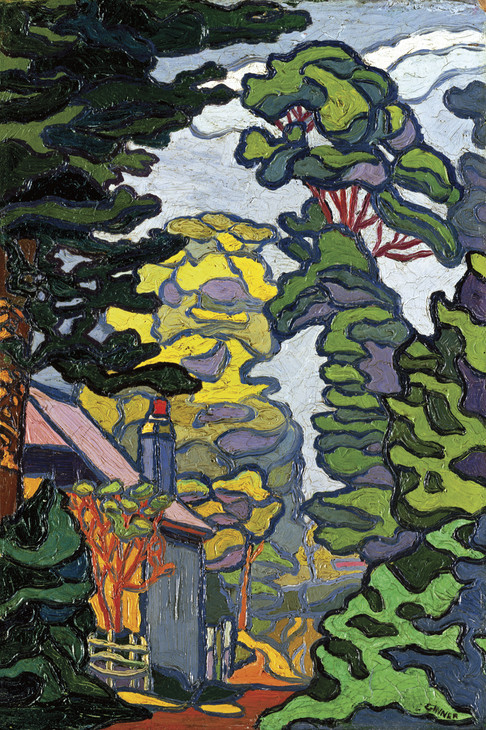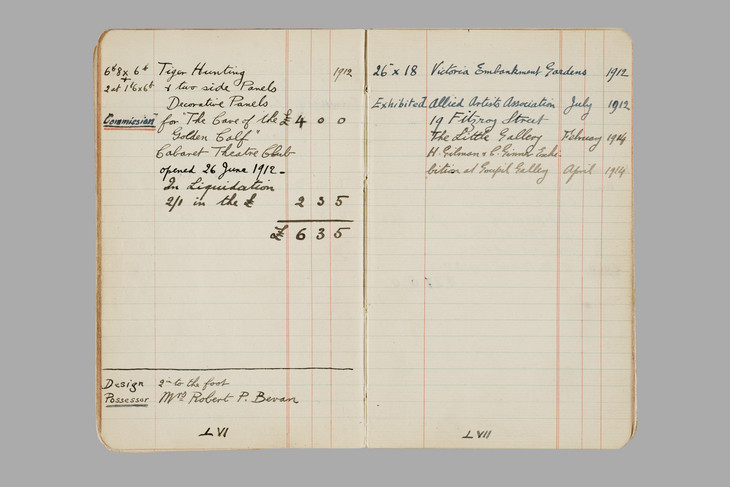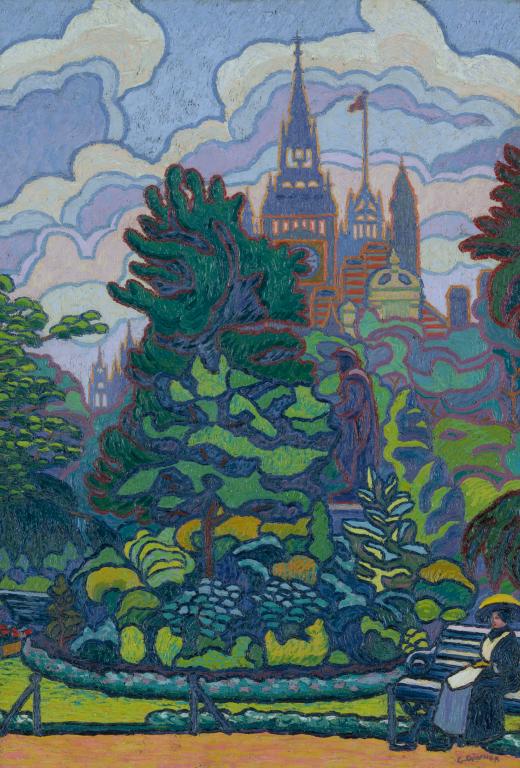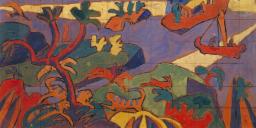Charles Ginner Victoria Embankment Gardens 1912
Charles Ginner,
Victoria Embankment Gardens
1912
The Houses of Parliament rise in the distant background of Ginner’s painting, composed from an unusual viewpoint in Victoria Embankment Gardens. The full foliage of summer obscures the buildings, including Big Ben, Victoria Tower with a flag at its pinnacle, the golden dome of the tower at Scotland Yard and the turrets of the Palace of Westminster on the lower left. Dwarfed in the foreground, a woman in a yellow hat sits on a park bench. Ginner’s expressive handling of thick paint with heavy outlines was an experiment he perhaps never repeated and may have been influenced by his appreciation of Vincent van Gogh.
Charles Ginner 1878–1952
Victoria Embankment Gardens
1912
Oil paint on canvas
660 x 455 mm
Inscribed ‘C. GINNER’ in red and blue oil paint bottom right
Purchased (Grant-in-Aid) 1984
T03841
1912
Oil paint on canvas
660 x 455 mm
Inscribed ‘C. GINNER’ in red and blue oil paint bottom right
Purchased (Grant-in-Aid) 1984
T03841
Ownership history
Probably in the artist’s possession at his death and inherited by his sister Ruby Dyer; probably given by Ruby Dyer to Anton Lock; sold Christie’s 9 June 1978 (59, reproduced pl.8) as ‘Property of Anton Lock’; bought by Anthony d’Offay Ltd., London, by whom sold to a private collector 1982; bought by Anthony d’Offay Ltd., London, by whom sold to Tate Gallery 1984.
Exhibition history
1912
The 5th London Salon: Allied Artists’ Association, Royal Albert Hall, London, July 1912 (75, £20).
1913
Fitzroy Street Group display, 19 Fitzroy Street, London 1913.
1914
Paintings, The Little Gallery, London, February 1914 (22).
1914
An Exhibition of Paintings by Harold Gilman and Charles Ginner, Goupil Gallery, London, April–May 1914 (57, as ‘Victoria Gardens’, £20).
1953–4
Charles Ginner 1878–1952, (Arts Council tour), Darlington Art Gallery, November 1953, Bristol City Art Gallery, November–December 1953, Carlisle Art Gallery, January 1954, Tate Gallery, London, January–February 1954, Southampton Art Gallery, February–March 1954, Assembly House, Norwich, March–April 1954 (4).
1971
British Paintings 1890–1928, Columbus Gallery of Fine Art, Ohio, February–March 1971 (32, reproduced).
1979–80
Post-Impressionism: Cross-Currents in European Painting, Royal Academy, London, November 1979–March 1980 (297, reproduced).
1980
The Camden Town Group, Yale Center for British Art, New Haven, April–June 1980 (42, reproduced p.30).
1982
British Painting 1895–1965, Anthony d’Offay Gallery, London, March–April 1982 (no number, reproduced on cover).
2006–7
El món d’Anglada-Camarasa, CaixaForum Barcelona, November 2006–March 2007, CaixaForum Palma, May–July 2007 (104, as ‘Jardins de Victoria Embankment’, reproduced).
2008
Modern Painters: The Camden Town Group, Tate Britain, London, February–May 2008 (3, reproduced front cover).
References
1914
‘Paintings by the Camden Town Group’, Athenæum, no.4504, 21 February 1914, p.281.
1954
‘Charles Ginner. Memorial Exhibition at the Tate’, Times, 30 January 1954, p.8.
1970
Malcolm Easton, ‘Charles Ginner: Viewing and Finding’, Apollo, vol.91, no.97, March 1970, pp.205–6, reproduced fig.4.
1977
Alexander Robertson, ‘Charles Ginner, Camden Town and Neo-Realism’, Leeds Art Calendar, no.80, 1977, p.10.
1978
Huon Mallalieu, ‘Auction record of £10,000 for Charles Ginner’, Times, 10 June 1978, p.14.
1980
Wendy Baron, ‘Charles Isaac Ginner’, in The Camden Town Group, exhibition catalogue, Yale Center for British Art, New Haven 1980, p.29.
1980
Bernard Denvir, ‘Individual Temperaments’, Art and Artists, vol.14, January 1980, p.16, reproduced p.17.
1980
Simon Watney, English Post-Impressionism, London 1980, p.144, n.34.
1985
Richard Cork, Art Beyond the Gallery in Early 20th Century England, New Haven 1985, p.77, reproduced fig.102.
1985
Export of Works of Art 1983–4: Thirtieth Report of the Reviewing Committee, London 1985, pp.42–3, reproduced pl.XII.
1986
The Tate Gallery 1982–84: Illustrated Catalogue of Acquisitions, London 1986, pp.187–8, reproduced p.187.
1997
Anna Gruetzner Robins, Modern Art in Britain, 1910–1914, exhibition catalogue, Barbican Art Gallery, London 1997, p.124.
2000
Wendy Baron, Perfect Moderns: A History of the Camden Town Group, Aldershot and Vermont 2000, pp.144, 175.
Technique and condition
Victoria Embankment Gardens is painted in artists’ oil paints on primed stretched canvas. The support is attached to a four-member stretcher with tacks, which are closely spaced to support the weight of the painting. The cloth is jute with a plain weave and coarse texture, due to the thick and uneven threads that are rather loosely woven. The canvas has a thin glue sizing and dense off-white priming, which has been evenly applied so as to retain the canvas weave texture and provide tooth. Two layers of primer have been applied; a thin opaque layer containing lithopone and gypsum over a thicker transparent grey layer containing synthetic blue ultramarine.1 The composition of the priming may be unusual for a British painting of this date, although Spencer Gore appears to have been using similar materials in his priming around 1912–13 (see Tate T01859 and T01960).
Visible evidence of preparatory work is obliterated by the paint film. Boldly delineated outlines enclose the tightly packed mosaic of shapes, with minimal detail or modulation of form. The paint is applied to a consistent thickness of around 3 mm. The shapes are painted in short strokes of opaque oil colour of a consistent viscosity. The emphatic brushwork is retained in peaks and troughs in the dried paint film. Each brushstroke is applied with minimum intermixing with previous work, although the paint is often worked wet-on-wet, there are strokes of contrasting broken colour sometimes applied over existing colours to enrich the colour effects, as in the foreground. The painting developed some areas of shrinkage cracks as the paint dried and subsequently brittle cracks that formed in the hardened, aged paint. This is apparently common in Ginner’s painting but is particularly noticeable in areas of lime green, dark red and olive brown coloured paint in this work (see also Tate T03096). The surface is unvarnished and retains the opaque, relatively matt aesthetic of the paint.
Roy Perry
September 2002
Notes
How to cite
Roy Perry, 'Technique and Condition', September 2002, in David Fraser Jenkins, ‘Victoria Embankment Gardens 1912 by Charles Ginner’, catalogue entry, May 2005, in Helena Bonett, Ysanne Holt, Jennifer Mundy (eds.), The Camden Town Group in Context, Tate Research Publication, May 2012, https://wwwEntry
The third of Ginner’s pictures of the centre of London, after The Café Royal 1911 (Tate N05050) and Leicester Square 1912 (Brighton Museum and Art Gallery), this work depicts the Houses of Parliament from an unusual viewpoint in Victoria Embankment Gardens. The two highest towers are half-hidden behind foliage: Big Ben on the left and the Victoria Tower, with a flag, on the right. Below them, looking like a crown, is the tower at the north end of Scotland Yard; at the left in a gap between the trees appear two of the smaller turrets of the Palace of Westminster. None of these buildings is painted accurately in detail. In the middle ground, not easily distinguished, is Edgar Boehm’s 1884 full-length statue of William Tyndale (1484–1536, the translator of the New Testament from Greek into English), while in the foreground a woman with a large yellow hat sits on a bench, possibly reading a book. The picture was painted in the early summer and so the buildings are partly concealed and largely upstaged by the patterning of the flower beds, bushes, trees and, behind everything, the clouds. There are no shadows to indicate the time of day, but the clock face of Big Ben might read three o’clock.

Charles Ginner 1878–1952
Neuville Lane 1911
Oil paint on canvas
285 x 190 mm
Private collection
© Estate of Charles Ginner
Photo © Christie’s Images Ltd
Fig.1
Charles Ginner
Neuville Lane 1911
Private collection
© Estate of Charles Ginner
Photo © Christie’s Images Ltd
In his appreciation of Harold Gilman, Ginner mentions that they discussed the paintings by Vincent van Gogh they had seen in a private collection in Paris, that of the brothers Josse and Gaston Bernheim.2 The visit was most probably in the early autumn of 1910.3 Admission to the private collection was probably arranged with Félix Fénéon (1861–1944), the critic and dealer who ran Bernheim-Jeune, the contemporary part of the commercial gallery on the Boulevard de la Madeleine. It is evident that Ginner was then already familiar with van Gogh’s painting, and was showing it to Gilman.
The art historian Wendy Baron considers that Ginner’s change in style in Victoria Embankment Gardens resulted from a renewed interest in van Gogh following this visit,4 and that he probably deliberately studied and imitated the Dutch artist’s painting as a way of escaping from the laborious application of paint in works like The Café Royal (Tate N05050) of the previous year. But Neuville Lane and Victoria Embankment Gardens should also be placed in the context of paintings by Maurice Denis which had been shown in Brighton in 1910,5 and which Ginner would have known from his time in Paris. The decorative, swirling lines of Ginner’s landscapes are also linked to the illustrations for magazines that he had drawn in the early 1900s.6 The Times reviewer wrote in 1954: ‘the painting exhibited in which he follows van Gogh most faithfully, the “Victoria Embankment Gardens” of 1912, emerges as a piece of pure decoration with a strong flavour of art nouveau’.7

Fig.2
Charles Ginner
List of Paintings, Drawings, Etc. of Charles Ginner. Book I 1910–18
Tate Archive TGA 9319/1
A very pleasant little show, made up of paintings of the Sickert School, or ‘Camden Town Group’, a few sculptures by Mr. Epstein and various productions of modern artistic craftsmanship has been arranged at the Little Gallery, 8 Marlborough Street, Regent Street. Some of the pictures have been seen before at other places, but there are some interesting new works by Mr. Walter Sickert, Mr. M.C. Drummond, Mr. C. Ginner and kindred spirits, most of whom look upon the world through purple glasses, which constitute the chief link between their otherwise very pronounced individualities.9
‘The sky is apocalyptic’, the art historian Richard Cork wrote in 1985 of this picture,10 considering it a precedent for the murals Ginner painted in May and June of 1912 in the Cave of the Golden Calf, a nightclub in Heddon Street, off Regent Street in London. The murals no longer exist but are known from Ginner’s studies.11 In their design Ginner played a game of hide-and-seek with the forms, showing African animals half-concealed behind trees painted in bright colours, similar to the overwhelming foliage in Victoria Embankment Gardens.
The painting was not exhibited between 1914 and Ginner’s memorial exhibition of 1953. Since no sale is recorded in his notebooks it was probably in the artist’s possession at his death in 1952. His sister Ruby Ginner Dyer inherited his pictures, and it is likely that she gave it to Anton Lock (1893–1971), who owned it at the time of the 1953 exhibition according to a note written on the stretcher. Lock was an artist and a friend who owned several of Ginner’s paintings and drawings already, and had supported him financially.12 He was a second-generation Camden Town artist in that he had been taught by both Sickert and Walter Bayes. He wrote the foreword to Ginner’s exhibition at the Leger Galleries in October 1951.
The Tate Gallery bid unsuccessfully for this painting at Christie’s on 9 June 1978, but purchased it in 1984 after an export licence was withheld by the Reviewing Committee on the Export of Works of Art.
David Fraser Jenkins
May 2005
Notes
Tate Archive TGA 9319/1, p.XLIII. This painting is depicted in the background of Malcolm Drummond’s At the Piano c.1912 (Art Gallery of South Australia), as it belonged to Drummond. Neuville was the area of Dieppe where Walter Sickert owned a small house from about 1902 to 1911. In 1911 Sickert was living in London until he went to Neuville after his marriage in July, and it may be that he lent his house to Ginner, as he had to Harold Gilman in 1907. While staying in Dieppe in 1911 Ginner painted three large views of the town and three small oils, including Neuville Lane.
Charles Ginner, ‘Harold Gilman: An Appreciation’, Art and Letters, vol.2, no.4, Summer 1919, pp.129–35.
Frank Rutter, ‘The Work of Harold Gilman and Spencer Gore: A Definitive Survey’, Studio, vol.101, no.456, March 1931, p.208.
Wendy Baron, The Camden Town Group, exhibition catalogue, Yale Center for British Art, New Haven 1980, p.29.
An Exhibition of the Work of Modern French Artists, Brighton Public Art Galleries, June–August 1910.
Reproductions of three of these illustrations are in Charles Ginner 1876–1952, exhibition catalogue, Fine Art Society, London 1985 (1–3).
The murals are listed in his notebook as decorative panels entitled Chasing Monkeys, Birds and Indians and Tiger Hunting, Tate Archive TGA 9319/1. A photograph of the lost Tiger Hunting mural and an oil study are reproduced in Cork 1985, figs.104 and 110, pp.78 and 82–3. For more on the Cave of the Golden Calf, see Tate T00446.
Related biographies
Related essays
- City Visions: The Urban Scene in Camden Town Group and Ashcan School Painting David Peters Corbett
- Canvas and its Preparation in Early Twentieth-Century British Paintings Sarah Morgan, Joyce H. Townsend, Stephen Hackney and Roy Perry
- Empire and the City: Early Films of London Maurizio Cinquegrani
Related catalogue entries
Related reviews and articles
- Charles Ginner, ‘Harold Gilman: An Appreciation’ in Memorial Exhibition of Works by the Late Harold Gilman, exhibition catalogue, Ernest Brown & Phillips, The Leicester Galleries, London, October 1919, pp.3–8.
How to cite
David Fraser Jenkins, ‘Victoria Embankment Gardens 1912 by Charles Ginner’, catalogue entry, May 2005, in Helena Bonett, Ysanne Holt, Jennifer Mundy (eds.), The Camden Town Group in Context, Tate Research Publication, May 2012, https://www



